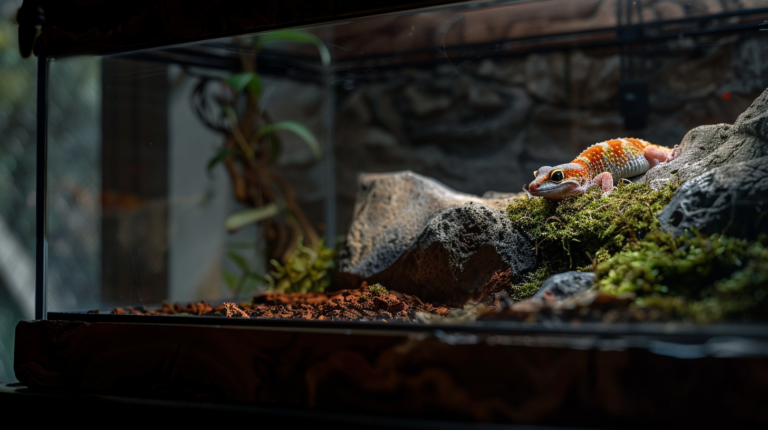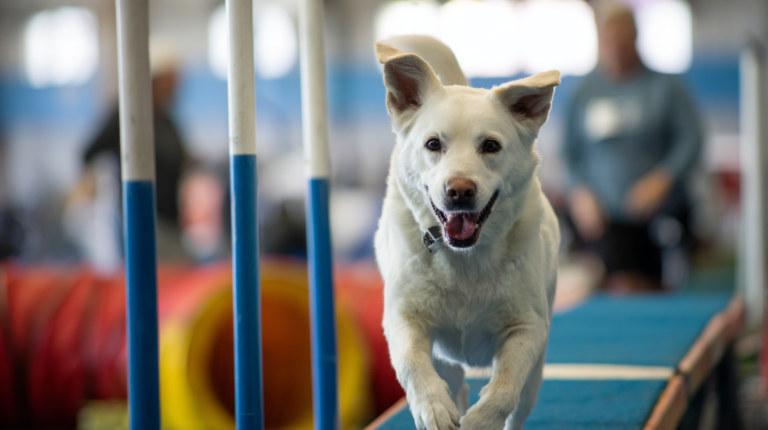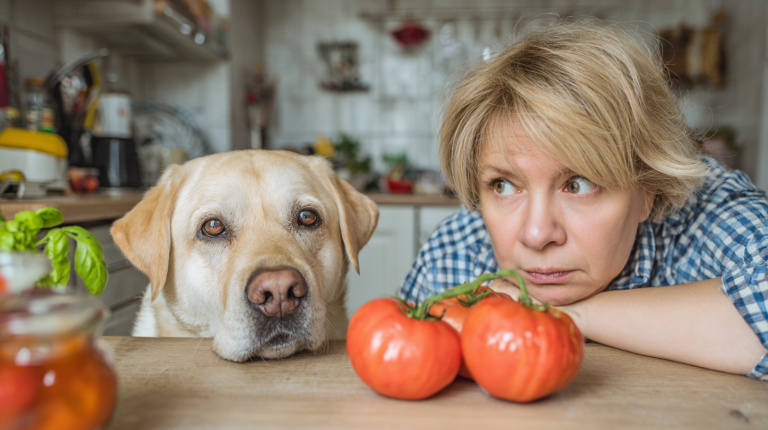Learn how to herd ducks effectively with 4 stress-free methods. Expert tips for duck owners on gentle herding techniques, safety, and building trust with your waterfowl.
Table of Contents
Herding ducks might seem like a straightforward task, but anyone who’s tried knows it can quickly become a chaotic chase scene. Whether you’re a backyard duck enthusiast, a small-scale farmer, or someone caring for rescued waterfowl, understanding how to herd ducks properly is essential for their wellbeing and your sanity. The key lies in working with their natural instincts rather than against them, creating a stress-free environment that benefits both you and your feathered friends.
Ducks are intelligent, social creatures with strong flocking instincts, but they can also be surprisingly stubborn when they feel pressured or threatened. Traditional herding methods often involve loud noises, rapid movements, and force – approaches that create unnecessary stress and can harm the human-duck relationship. Instead, successful duck herding relies on patience, understanding duck behavior, and employing gentle techniques that respect their natural tendencies.
In this comprehensive guide, we’ll explore four proven methods for herding ducks without causing stress, along with essential safety considerations, common mistakes to avoid, and expert insights that will transform your approach to duck management. These techniques have been tested by professional waterfowl handlers and backyard enthusiasts alike, proving effective for various duck breeds and situations.
Understanding Duck Psychology and Natural Behavior
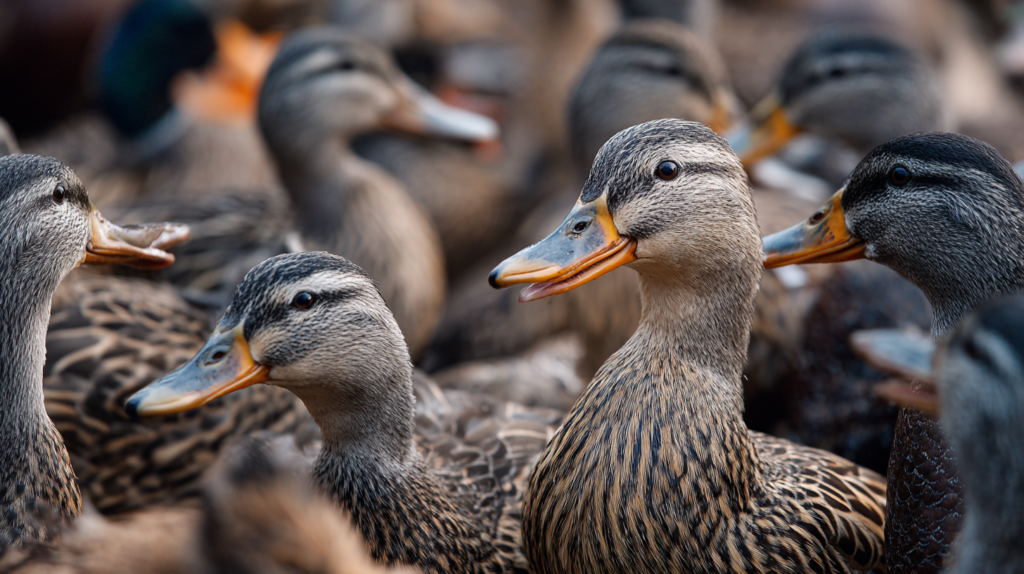
Before diving into specific herding techniques, it’s crucial to understand what motivates ducks and how they respond to different stimuli. Ducks are prey animals with highly developed survival instincts, which means they’re naturally cautious and easily startled by sudden movements or unfamiliar sounds.
The Flocking Instinct
Ducks have an inherent tendency to move as a group, a behavior that stems from their wild ancestry where staying together meant better protection from predators. This flocking instinct is your greatest ally when learning how to herd ducks effectively. When one duck moves in a particular direction, others typically follow, creating a natural chain reaction that skilled handlers can leverage.
According to Dr. Sarah Mitchell, an avian behaviorist at the University of California Davis, “Ducks maintain visual contact with their flock members and will become distressed if separated for extended periods. This social bond is what makes gentle herding possible – you’re working with their natural desire to stay together rather than forcing individual compliance.”
Stress Indicators in Ducks
Recognizing stress signals helps you adjust your herding approach before problems escalate. Common stress indicators include:
- Rapid breathing or panting
- Excessive wing flapping
- Loud, distressed quacking
- Attempting to hide or escape
- Aggressive posturing toward other ducks
- Freezing in place
When you notice these behaviors, it’s time to slow down, step back, and reassess your approach.
Method 1: The Food Motivation Technique
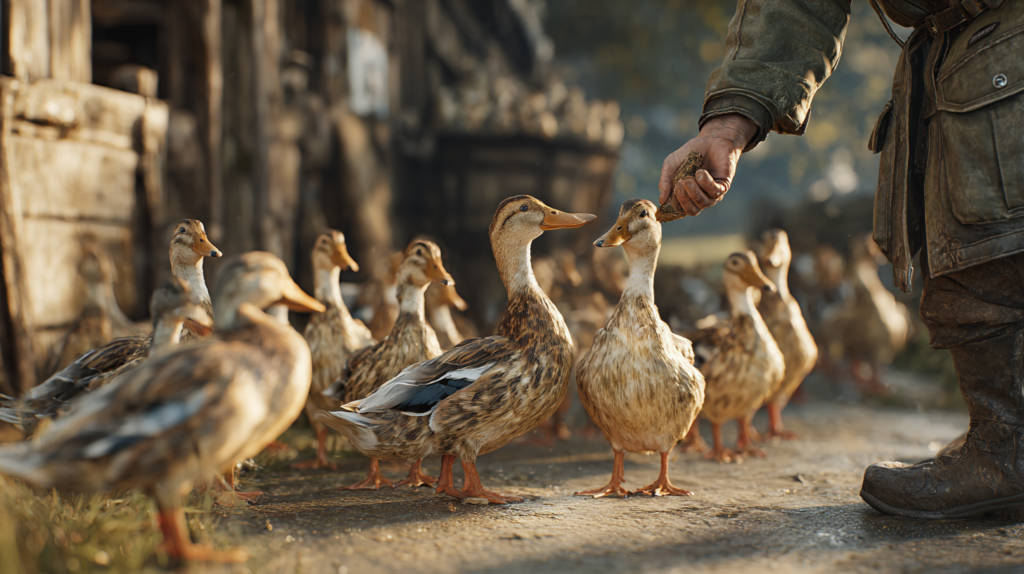
The most effective and stress-free way to move ducks from one location to another involves using their natural feeding instincts. This method works exceptionally well because it transforms herding from a potentially frightening experience into a positive, reward-based interaction.
How to Implement Food Motivation Herding
Step 1: Establish a Feeding Routine Start by creating consistent feeding times and locations. Ducks thrive on routine and will quickly learn to associate specific times and places with food. This foundation makes future herding much easier.
Step 2: Choose the Right Treats Effective herding treats should be:
- Highly desirable (cracked corn, dried mealworms, or special duck pellets)
- Easy to scatter in the desired direction
- Safe for duck consumption
- Visible to the entire flock
Step 3: Practice the Technique Begin by shaking a container of treats to get the ducks’ attention. Most ducks will immediately recognize this sound after a few repetitions. Slowly walk in the direction you want them to go while periodically scattering small amounts of treats. The flock will naturally follow the trail of food.
Success Statistics and Case Studies
A study conducted by the American Waterfowl Association found that food-motivated herding reduced stress indicators in ducks by 78% compared to traditional chasing methods. Professional duck farmer John Peterson from Oregon reports, “I’ve been using food motivation for over 15 years with my flock of 200 ducks. Not only is it more humane, but it’s actually faster once the ducks understand the routine. What used to take three people and 30 minutes now takes one person and 5 minutes.”
Pros and Cons of Food Motivation
Advantages:
- Builds positive associations with human handlers
- Works consistently across all duck breeds
- Reduces stress for both ducks and handlers
- Can be combined with training for other behaviors
Limitations:
- Requires advance planning and treat preparation
- May not work immediately before regular feeding times
- Less effective with very young ducklings who haven’t learned food associations
Method 2: The Herding Panel System

Herding panels offer a visual barrier method that guides ducks without physical contact or intimidation. This technique mimics natural boundaries that ducks encounter in their environment, making it feel less threatening than human-directed movement.
Understanding Panel Herding Psychology
Ducks naturally avoid obstacles and prefer clear pathways, especially when moving as a group. Herding panels create artificial boundaries that channel the flock’s movement in desired directions while maintaining their sense of safety and group cohesion.
Setting Up Effective Herding Panels
Panel Specifications:
- Height: 2-3 feet (tall enough to discourage jumping but not so tall as to feel imprisoning)
- Material: Lightweight but sturdy (plywood, plastic sheeting, or specialized herding panels)
- Width: 4-6 feet per panel for easy handling
- Color: Solid colors work better than transparent materials
Implementation Strategy: Position two or more people with panels to create a “funnel” effect, gradually narrowing the available path toward your destination. Move slowly and maintain consistent spacing between panels. The key is to guide, not chase – let the ducks choose to move forward rather than feeling forced.
Professional Techniques for Panel Herding
Livestock handling expert Temple Grandin’s principles apply beautifully to duck herding: “Animals move away from pressure and toward release. When using panels, apply gentle pressure by positioning them in the duck’s flight zone, then provide clear escape routes in the direction you want them to go.”
Advanced Panel Techniques:
- The Pivot Method: One person holds a stationary panel while another creates a moving boundary
- Progressive Narrowing: Start with wide openings and gradually reduce space as ducks commit to the direction
- Backup Barriers: Position stationary panels to prevent backtracking once forward movement begins
Equipment Recommendations and Costs
| Panel Type | Cost Range | Durability | Portability | Best Use Case |
| Plywood Panels | $25-40 each | High | Low | Permanent setups |
| Plastic Herding Panels | $35-60 each | Medium | High | Mobile operations |
| Professional Livestock Panels | $80-120 each | Very High | Medium | Commercial use |
| DIY PVC Frame Panels | $15-25 each | Medium | High | Budget-conscious owners |
Method 3: The Natural Flow Technique

This sophisticated approach involves understanding and working with the ducks’ natural movement patterns and preferences. Rather than directing them against their instincts, you learn to predict where they want to go and create conditions that make your desired destination the most attractive option.
Observing Natural Duck Movement Patterns
Ducks don’t move randomly – they follow predictable patterns based on environmental factors, time of day, weather conditions, and their biological needs. Successful natural flow herding requires careful observation of these patterns over time.
Key Movement Triggers:
- Time-based patterns: Most ducks are more active during cooler parts of the day
- Weather influences: They seek shelter before storms and sun after rain
- Terrain preferences: Ducks prefer level ground and avoid steep inclines when possible
- Water proximity: They’re drawn to water sources, especially for drinking and bathing
- Safety considerations: They move away from areas where they feel exposed or threatened
Creating Attractive Pathways
Instead of forcing ducks to go where you want, make your destination the place they naturally want to be. This might involve:
Environmental Modifications:
- Placing fresh water sources in target areas
- Creating shade structures in hot weather
- Removing obstacles from preferred pathways
- Using natural windbreaks to create comfortable spaces
Timing Strategies:
- Schedule herding during natural movement times
- Work with daily routines rather than disrupting them
- Allow extra time for the process to unfold naturally
Case Study: Sunset Herding Success
Maria Gonzalez, who manages a rescue sanctuary for 50+ ducks in Texas, developed a highly effective natural flow system: “I noticed my ducks always moved toward the pond around sunset for their evening swim. Instead of trying to get them into the shelter immediately, I placed their evening food near the shelter entrance. After their swim, they naturally flowed toward the food and were already 90% of the way to where I needed them for the night. What was once a stressful 45-minute ordeal became a 10-minute peaceful transition.”
Seasonal Considerations for Natural Flow Herding
Spring and Summer:
- Ducks are more active and cover greater distances
- Heat avoidance becomes a primary motivator
- Breeding behaviors may affect flock dynamics
Fall and Winter:
- Movement patterns become more predictable
- Food sources become primary motivators
- Weather protection drives location choices
Method 4: The Gentle Pressure and Release System
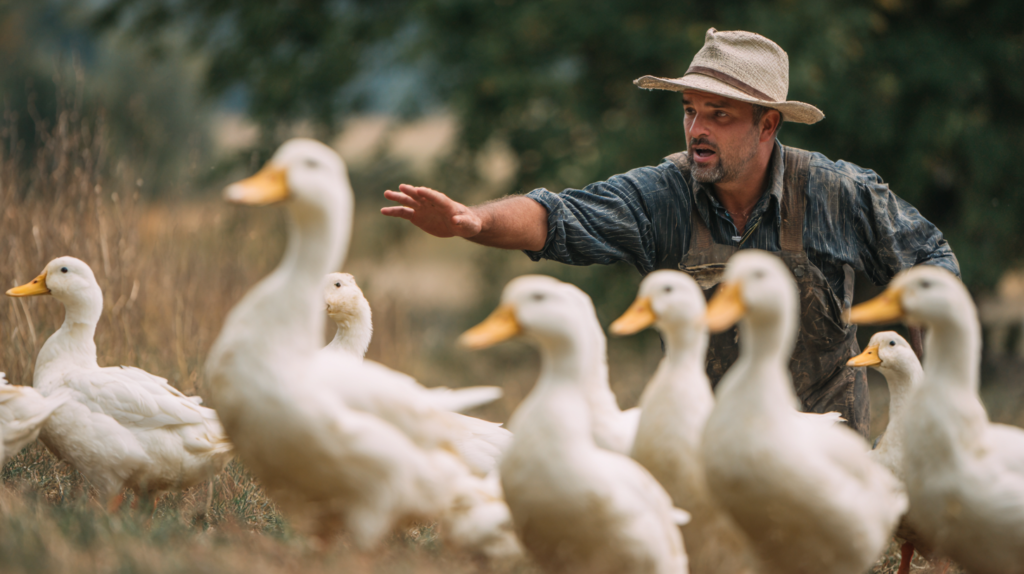
This method, adapted from professional livestock handling techniques, uses the concept of pressure zones and flight distances to guide ducks without causing panic. It requires the most skill to master but offers the greatest flexibility once learned.
Understanding Pressure Zones
Every duck has an invisible “flight zone” – a distance bubble around them that, when entered, triggers a move-away response. The size of this zone varies based on the individual duck’s temperament, previous experiences, and current stress level. Learning to work at the edge of this zone allows you to influence movement without creating panic.
Flight Zone Characteristics:
- Typically 10-15 feet for calm, domesticated ducks
- Larger (20+ feet) for nervous or semi-wild ducks
- Smaller (5-8 feet) for very tame, hand-raised ducks
- Changes based on approach angle and handler body language
Implementing Pressure and Release
Basic Technique Steps:
- Position yourself at the edge of the flight zone behind and slightly to one side of the group
- Apply gentle pressure by stepping slightly closer or raising your arms slowly
- Watch for the first sign of movement in your desired direction
- Immediately release pressure by stepping back or lowering your arms
- Allow the movement to continue without additional pressure
- Repeat the process as needed to maintain momentum
Advanced Pressure Techniques
The Parallel Approach: Walk alongside the flock rather than directly behind them. This creates a gentle pushing pressure without triggering panic responses.
Body Language Optimization:
- Keep your body profile low and non-threatening
- Move smoothly without sudden gestures
- Maintain calm, slow breathing
- Avoid direct eye contact with individual ducks
- Use peripheral vision to monitor the entire flock
Voice Modulation: Soft, consistent sounds can help maintain calmness. Many professional handlers develop a specific “duck voice” – a low, gentle tone that becomes familiar and non-threatening to their flocks.
Expert Insights on Pressure Systems
Dr. James Crawford, a veterinary behaviorist specializing in poultry, explains: “The pressure and release system works because it mimics natural predator-prey dynamics without triggering full fear responses. When applied correctly, ducks perceive the pressure as a gentle suggestion rather than a threat, maintaining their ability to make choices about movement direction.”
Safety Considerations and Best Practices
Regardless of which herding method you choose, safety should always be your top priority. Both human and duck safety require careful attention to environmental hazards, proper preparation, and emergency protocols.
Environmental Safety Checklist
Before beginning any herding operation, conduct a thorough safety assessment:
Ground Conditions:
- Check for holes, uneven surfaces, or slippery areas
- Remove debris that could cause injury
- Ensure adequate traction for both ducks and handlers
- Consider weather effects on footing
Pathway Hazards:
- Identify and mark low-hanging branches or wires
- Remove or secure loose objects that could startle ducks
- Check for other animals that might interfere
- Ensure adequate lighting for evening operations
Destination Safety:
- Verify the target area is ready to receive the ducks
- Check water sources for cleanliness and depth appropriateness
- Ensure adequate ventilation in enclosed spaces
- Confirm food and water availability
Emergency Protocols
If Ducks Become Separated:
- Stop all herding activities immediately
- Allow separated ducks to call to their flock
- Never chase individual ducks – they’ll usually return to the group on their own
- If necessary, use food motivation to reunite stragglers
Signs to Stop Herding Immediately:
- Any duck showing severe distress symptoms
- Aggressive behavior between flock members
- Environmental hazards (sudden weather changes, predator presence)
- Handler fatigue or loss of control
First Aid Preparedness:
- Keep a basic first aid kit accessible for both humans and ducks
- Know the location and contact information for the nearest veterinarian experienced with waterfowl
- Have emergency contact numbers readily available
- Maintain basic knowledge of duck injury assessment
Legal and Ethical Considerations
In many areas, herding techniques are regulated, especially for commercial operations or rescue facilities. Research local requirements and consider these ethical guidelines:
- Always prioritize animal welfare over convenience
- Use the least stressful method effective for your situation
- Provide adequate rest periods between herding sessions
- Maintain detailed records of herding activities and duck responses
- Seek professional training if managing large flocks or commercial operations
Common Mistakes and How to Avoid Them
Learning how to herd ducks effectively means understanding not just what to do, but what not to do. These common mistakes can set back your training progress and damage your relationship with your flock.
Mistake 1: Moving Too Quickly
The Problem: Rushing the herding process creates panic and scatters the flock, making the task exponentially more difficult.
The Solution: Plan for twice as much time as you think you’ll need. Slow, deliberate movements keep ducks calm and actually result in faster overall completion times.
Expert Tip: “Think of duck herding like conducting an orchestra,” says professional animal trainer Lisa Park. “Your job is to guide the tempo, not force it. When you rush, everyone gets out of sync.”
Mistake 2: Ignoring Individual Duck Personalities
The Problem: Treating all ducks the same ignores individual temperaments and can cause unnecessary stress for sensitive birds.
The Solution: Learn to identify your flock’s leaders, followers, and nervous individuals. Adjust your approach accordingly.
Personality Types to Recognize:
- Leaders: Often move first and influence others
- Followers: Wait to see what the group does
- Scouts: Investigate new situations cautiously
- Nervous ducks: Need extra patience and distance
Mistake 3: Inadequate Preparation
The Problem: Starting to herd without proper setup leads to improvisation and mistakes.
The Solution: Develop a pre-herding checklist and stick to it every time.
Essential Preparation Steps:
- Clear and inspect the intended pathway
- Prepare necessary equipment (treats, panels, etc.)
- Check weather conditions and adjust timing if needed
- Ensure all handlers understand their roles
- Have backup plans for common complications
Mistake 4: Overuse of Herding
The Problem: Herding ducks too frequently can create chronic stress and make them increasingly difficult to manage.
The Solution: Minimize herding to essential situations only. Combine multiple objectives into single herding sessions when possible.
Mistake 5: Inconsistent Techniques
The Problem: Switching between different herding methods confuses ducks and prevents them from learning your system.
The Solution: Choose one primary method and stick with it. Only introduce variations after your flock has mastered the basic technique.
Advanced Tips for Different Duck Breeds and Situations
Not all ducks respond identically to herding techniques. Breed characteristics, age, and environmental factors all influence the most effective approaches.
Breed-Specific Considerations
Large Breeds (Pekin, Rouen, Buff Orpington):
- Generally calmer and easier to herd
- Move more slowly, requiring patience
- Less likely to panic but harder to motivate
- Food motivation works exceptionally well
Small Breeds (Call Ducks, East Indies):
- More agile and quick to startle
- Require gentler approaches and greater distances
- Benefit from smaller group sizes during herding
- Natural flow techniques often work best
Runner Ducks:
- Naturally active and can move quickly
- Respond well to panel herding due to their ground-covering nature
- May require more frequent rest stops
- Excel at following established pathways
Age-Related Adaptations
Ducklings (0-8 weeks):
- Follow closely behind adults automatically
- Focus herding efforts on adult birds
- Provide frequent rest and warmth breaks
- Use shorter distances and slower paces
Juvenile Ducks (8-20 weeks):
- Most challenging age group to herd
- May test boundaries and try to separate from the group
- Require firm but patient guidance
- Benefit from consistent routines
Adult Ducks (20+ weeks):
- Most predictable and manageable
- Respond well to all herding techniques
- Can handle longer distances and more complex routes
- Form stable social hierarchies that aid herding
Seasonal Herding Adaptations
Spring Herding Challenges:
- Breeding behaviors may disrupt normal flock dynamics
- Pairs may try to separate from the group
- Increased territorial behaviors require wider spacing
- Nesting instincts may draw ducks to inappropriate areas
Summer Strategies:
- Schedule herding during cooler parts of the day
- Provide shade and water breaks during longer moves
- Watch for heat stress symptoms
- Use water sources as destination motivators
Fall Preparations:
- Ducks may be more food-motivated as they prepare for winter
- Weather changes require flexible timing
- Molting birds may move more slowly
- Begin establishing winter routines
Winter Considerations:
- Ice and snow create additional safety hazards
- Ducks may be less active and require gentler motivation
- Shelter becomes a primary motivator
- Shorter daylight hours limit herding windows
Building Long-Term Relationships Through Herding
Effective duck herding isn’t just about moving birds from point A to point B – it’s about building trust and communication that enhances your overall relationship with your flock. When done correctly, herding becomes a collaborative effort rather than a battle of wills.
Trust-Building Strategies
Consistency is Key: Use the same signals, timing, and rewards each time you herd. Ducks learn patterns quickly and feel more secure when they can predict what’s expected of them.
Positive Associations: Always end herding sessions on a positive note. Whether that’s reaching a favorite area, receiving treats, or simply being left alone, ducks should associate the end of herding with good things.
Respect Individual Boundaries: Some ducks will always be more nervous than others. Acknowledge these differences and give anxious birds extra space and time.
Training Progressive Skills
As your flock becomes comfortable with basic herding, you can gradually introduce more complex skills:
Directional Commands: Teach your ducks to respond to specific vocal cues for left, right, stop, and go.
Distance Work: Gradually increase the distances you can effectively herd your flock.
Multiple Handler Coordination: Train your ducks to work with different family members or helpers.
Obstacle Navigation: Practice herding through gates, around corners, and over varied terrain.
Measuring Success
Track your progress with these indicators:
- Reduced time needed for routine herding
- Decreased stress behaviors during herding
- Improved response to initial herding cues
- Greater willingness to approach handlers
- Maintained flock cohesion throughout the process
Troubleshooting Common Herding Problems
Even experienced duck handlers encounter challenges. Here are solutions to the most common herding problems:
Problem: Ducks Scattering in Multiple Directions
Likely Causes:
- Moving too quickly or aggressively
- Startling the flock with sudden movements or noises
- Not identifying and working with the flock leader
Solutions:
- Stop all movement and allow the flock to regroup
- Identify the dominant duck and focus herding efforts on moving that individual
- Reduce pressure and increase distance from the flock
- Use food motivation to encourage regrouping
Problem: Individual Ducks Refusing to Move
Likely Causes:
- Health issues or injury
- Broody behavior (wanting to nest)
- Extreme fear or previous negative experiences
- Attachment to current location
Solutions:
- Conduct a gentle health check for injuries or illness
- Allow extra time and use patient encouragement
- Try different motivational approaches (food, water, social pressure)
- Consider whether movement is truly necessary at this time
Problem: Flock Moving in Wrong Direction
Likely Causes:
- Misreading the ducks’ natural preferences
- Competing attractions (food, water, other ducks elsewhere)
- Inadequate pathway preparation
- Handler positioning errors
Solutions:
- Reassess the environment for competing attractions
- Adjust handler positions to create clearer directional pressure
- Use temporary barriers to close off undesired pathways
- Increase motivation toward the desired destination
Technology and Tools for Modern Duck Herding
While traditional methods remain effective, modern technology can enhance your herding capabilities:
GPS and Mapping Tools
For larger properties or complex herding routes, GPS mapping can help you:
- Plan optimal pathways between locations
- Track which routes work best for your flock
- Coordinate multiple handlers across large areas
- Document successful strategies for future reference
Camera Systems for Behavior Analysis
Installing cameras along common herding routes allows you to:
- Review and improve your techniques
- Identify stress patterns you might miss in real-time
- Train other family members or helpers
- Document progress over time
Weather Monitoring Applications
Real-time weather data helps optimize herding timing:
- Avoid herding during approaching storms
- Schedule activities during temperature-appropriate windows
- Plan for seasonal changes in duck behavior
- Ensure safety during extreme weather conditions
For more expert pet care tips and product recommendations, visit BlithePet.com — your trusted source for pet wellness.
Frequently Asked Questions
How often should I herd my ducks?
Herd your ducks only when necessary for their safety, health, or management needs. Daily herding can create chronic stress, so limit it to essential situations like moving them to shelter, veterinary care, or seasonal relocations. Most backyard flocks need herding 2-3 times per week at most.
What’s the best time of day to herd ducks?
Early morning (just after sunrise) and early evening (before sunset) are optimal times for herding ducks. These periods align with their natural activity patterns and avoid the heat of midday. Ducks are typically calmer and more cooperative during these cooler parts of the day.
Can I herd ducks alone, or do I need multiple people?
For small flocks (fewer than 20 ducks), one person can effectively herd using food motivation or natural flow techniques. Larger flocks benefit from 2-3 handlers using coordinated panel herding or pressure systems. The key is having enough coverage to prevent the flock from scattering while maintaining calm, controlled movements.
How do I know if my herding technique is causing stress?
Watch for stress indicators including rapid breathing, excessive wing flapping, loud distressed quacking, attempts to hide or escape, and aggressive behavior between flock members. If you notice these signs, immediately stop herding, give the ducks space to calm down, and reassess your approach using gentler techniques.
What should I do if a duck gets injured during herding?
Stop all herding activities immediately and assess the injury. For minor scrapes or bruises, clean the area gently and monitor for improvement. Serious injuries require immediate veterinary attention. Always have a first aid kit available and know your emergency veterinary contact information before beginning any herding session.
Do different duck breeds require different herding approaches?
Yes, breed characteristics significantly affect herding success. Large breeds like Pekins are generally calmer and respond well to food motivation, while smaller breeds like Call Ducks need gentler approaches with greater distances. Runner ducks are naturally active and work well with panel herding, while nervous breeds benefit most from natural flow techniques.
Conclusion
Learning how to herd ducks effectively transforms a potentially stressful experience into a collaborative partnership between you and your feathered friends. The four methods outlined in this guide – food motivation, herding panels, natural flow techniques, and pressure and release systems – each offer unique advantages that can be adapted to your specific situation and flock personality.
Remember that successful duck herding is built on patience, understanding, and respect for your ducks’ natural behaviors. By working with their instincts rather than against them, you’ll develop a system that reduces stress for everyone involved while building stronger bonds with your flock.
The key to mastering these techniques lies in consistent practice, careful observation, and willingness to adapt your approach based on your ducks’ responses. Start with the method that feels most comfortable for your situation, and gradually incorporate elements from other techniques as your skills and confidence grow.
Whether you’re managing a small backyard flock or a larger commercial operation, these stress-free herding methods will serve you well for years to come. Your ducks will be happier, healthier, and more cooperative, while you’ll find that what once seemed like an impossible task becomes a routine part of duck care that you might even enjoy.
Have a similar experience with your pet? Share it in the comments below!


